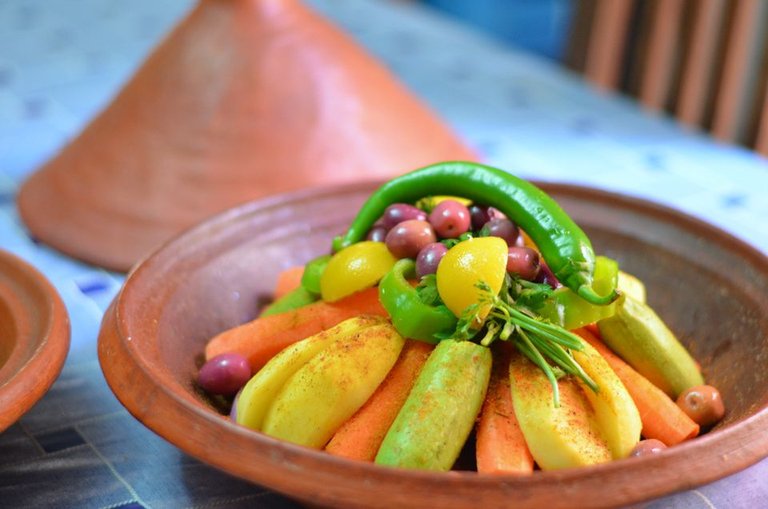If you own a tagine but have been too intimidated to try using it, don't feel bad. Because to day I am going to show you how to cook a delicious meal in it. the following pictures will show you step-by-step how easy it is to prepare a fabulous Moroccan stew in this traditional cookware. In the following picture there are a ceramic tagine and an unglazed clay tagine. Both are quite common in Morocco, but I prefer the unglazed because it adds rustic, earthy flavor and aroma to whatever is being cooked in it. Both types should be seasoned before first use. The base of a Moroccan tagine is wide and shallow; the conical lid helps return condensed steam back to the food.
The second step is to arrange a layer of onions for your base as a bed for the remaining ingredients, the reason behind creating a bed of onions is to help avoid meat from adhering to the bottom and burning. 
Next you should add the garlic , the garlic is an essential ingredient in any Moroccan meal.

After adding the garlic it is time to add some olive oil to our tagine. Ample oil is the foundation of a rich sauce in a tagine, so don't be afraid to use the full amount called for in a recipe. Most of my tagine recipes specify 1/4 to 1/3 cup oil; sometimes at home I use even a little bit more to ensure there's ample sauce for my large family to sop up with Moroccan bread.![tagine-5-meat-56a6467c5f9b58b7d0e0c573.jpg]
( )
)
Now it is time to add some meat, it should be arranged in the center asyou can see in the picture above. If you're using meat-on-the-bone, place pieces bone side down to reduce risk of scorching the meat. Sometimes you'll encounter recipes which direct you to brown the meat first. It's really not necessary. If you do decide to brown the meat, it's best done in a separate skillet since a clay or ceramic tagine should not be used over high heat.

Mix the Moroccan Spices, this step is very preferable in order to give flavor to your tagine. You can use a mixture of salt, pepper, ginger, paprika, cumin, turmeric, saffron and a little cayenne pepper in a small bowl since I'll be sprinkling the seasoning over ingredients.
the seventh step is to season the meat and onions.Distribute some of the spice mixture over the meat and onions. You can use up to two-thirds of the mixture at this step, concentrating the seasoning on the onions so the spices will meld with the oil and liquids to make a rich, flavorful sauce. The reserved spices will be used to season the vegetables

Now it is time to add some vegetables, here we arrange the vegetables and season them.When using a tagine, the vegtables are usually added at the very beginning of cooking along with the meat. Some recipes call for layering the vegetables around the meat, poultry or fish, but in a Berber style tagine they're arranged in conical fashion.

Now you can garnish your tagine. you can dress up the tagine with color and flavor by adding strips or slices of bell pepper, preserved lemon, olives and an herb bouquet of parsley and cilantro, a jalapeno you can even add pepper if you like to.
In this step you must add some water to your tagine. Because it is the last step before you place the tagine on the stove is to add water (sometimes stock or broth is used instead). Pour it carefully into the tagine near the side so that you don't wash away the spices on the veggies. Be aware that you should not add a hot liquid to a cold tagine, and vice versa, as thermal shock can crack a clay or ceramic tagine. you can add till two cups of water to your tagine depending on the size of it.
It is now time to place the tagine over low to medium-low heat and be very patient while the tagine slowly reaches a simmer.(NB:To avoid cracking or breaking a clay or ceramic tagine, make sure it sits above the heat source and not directly on it)
Once a tagine reaches a simmer (it can take up to a half hour if there is a lot of liquid), it can be left relatively undisturbed to slowly stew. Reduce the heat slightly if the tagine is simmering rapidly; ideally you want a slow or medium simmer instead.Check the level of the liquids - When to add more water.
The tagine still has ample liquid, so there is no need to add any water for the last hour of cooking, you should justcheck if the process is going well.
The last step is to serve the tagine. Moroccan tradition is to gather round and eat communally from the tagine, using pieces of Moroccan bread. it's best allow the tagine to cool for 10 or 15 minutes before digging in or there will be burnt fingers and tongues!
bon appétit !
Hi! I am a robot. I just upvoted you! I found similar content that readers might be interested in:
https://www.thespruce.com/cooking-in-a-moroccan-tagine-steps-2395002
ah okey